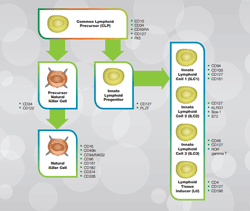Mini-review: NK Cell and Receptor Antibodies

- On This Page
- NK overview
- Activating and inhibitory receptors
- Cell development
- Cell markers
- Cell antibodies
- References

NK Cell and Receptor Antibodies Mini-review
Download PDF
Overview
Natural killer (NK) cells are a subset of cytotoxic lymphocytes that function predominately in the innate immune response. They were named “natural killers” because of the initial notion that they did not require activation in order to perform their cytotoxic functions. NK cells play a major role in the rejection of cells lacking the self-markers of MHC class I, particularly tumor and virus infected cells.
NK cell function is controlled by a wide range of cell surface receptors, which either have an activating cytotoxic function, or are inhibitory having an immunoregulatory role (Mandal and Viswanathan 2014), examples of these receptors are show in the table below. The intensity of the expression of CD56 on human NK cells has been seen as an indicator of function; with CD56bright NK cells (10% of the population) being inhibitory (producing cytokines) and CD56dim NK cells (90% of the population) being cytotoxic (Caligiuri 2008). Cytotoxicity is regulated by the interplay between activating and inhibitory signals. Inhibitory receptors prevent NK activation by recognition of self MHC class I.
NK cell activating and inhibitory receptors
Activating Receptors |
Inhibitor Receptors |
|---|---|
|
Natural cytotoxic receptors – NKp46 & NKp44 |
KIR or Ig like receptors – CD158 |
|
C type lectin receptors – NKG2D & CD94-NKG2C |
C type lectin receptors – CD94-NKG2A |
|
Ig Like receptors – 2B4 |
Leukocyte inhibitory receptors – LIR1 & LAIR-1 |
NK cell cytotoxicity is mediated mainly by three pathways (Mandal and Viswanathan 2014):
- Degranulation – controlled by receptors such as NKG2D and DNAM1, where disrupting proteins such as perforin and granzyme are secreted by exocytosis, perforating the targeted cell membrane inducing apoptosis
- Caspase dependent apoptosis – death receptors such as FAS/CD95/TRAILR associate with their receptors on the NK cells
- Antibody dependent cellular cytotoxicity – in tumor cells as they express low affinity Fc receptor for CD16
NK cell development
While NK cells express cell surface molecules that are also found on B cells they are morphologically and functionally more similar to T cells. Development is primarily in the bone marrow, like cells from the myeloid lineage, but NK cell development can also take place in the lymph nodes and liver (Freud et al. 2005 and Andrews and Smyth 2010). NK cells arise from the lymphoid lineage being derived from a CD34+ common lymphoid precursor cells; developing into a NK cell after progressing through an intermediate Pro natural killer cell stage. During these stages of development, different surface antigens are expressed enabling detection of these specific cells. Figure 1 below shows the NK cell lineage of both humans and mice alongside key markers for the different stages of development. For further information on NK cell development, refer to our NK cell mini-review.
Figure 1: Human (a) and mouse (b) NK cell lineage. Click on the relevant NK cell lineage image to obtain human and mouse specific posters and guides.
NK cell markers
Traditionally, in humans, NK cells are defined as CD56+ and CD3- and in mice as CD161+ (NK1.1). Many other markers have been discovered including those that identify NK cells at various stages of development or indicate whether the NK cell is involved in activation (cytotoxic) or inhibitory functions. For full details of these markers, refer to our NK cell mini-review, which lists these markers for human and mice.
NK Cell Antibodies
| Description | Target | Format | Clone | Applications | Citations | Code |
|---|
References
- Andrews DM and Smyth MJ (2010). A potential role for RAG-1 in NK cell development revealed by analysis of NK cells during ontogeny. Immunol Cell Biol. 88, 107-116.
- Caligiuri MA (2008). Human natural killer cells. Blood. 112, 461-469.
- Freud AG et al. (2005). A human CD34(+) subset resides in lymph nodes and differentiates into CD56bright natural killer cells. Immunity. 22, 295-304.
- Mandal A and Viswanathan C (2014). Natural killer cells: in health and disease. Hematology/Oncology and Stem Cell Therapy. 8, 47-55.






